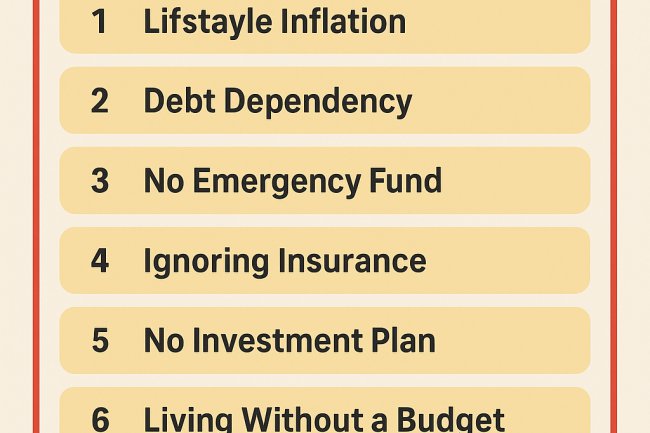The 3-Account Rule for Financial Clarity
Learn the 3-Account Rule — a globally effective method for financial clarity. Discover how to divide your income into three simple accounts for spending, saving, and freedom, and gain lasting control over your money.

One for needs. One for goals. One for freedom.
Introduction: Clarity Is the New Currency
Money itself isn’t stressful. What’s stressful is not knowing where your money is going.
Most people mix all their expenses, savings, and leisure funds in one account. Rent, groceries, bills, savings, travel — everything flows in and out of the same place. The result? You constantly feel like your money disappears faster than it should.
The problem isn’t your income. It’s your lack of structure.
Financial freedom begins the moment you create a clear system for how money enters, moves, and exits your life. One of the simplest and most powerful systems ever developed is called The 3-Account Rule — a method used by financially successful individuals worldwide to create clarity, discipline, and peace of mind.
This approach organizes your income into three distinct categories:
-
Spending Account – for your daily needs
-
Savings and Investment Account – for your future goals
-
Freedom Fund – for lifestyle enjoyment
Let’s explore how it works.
Why Most People Stay Financially Stuck
Many people earn enough money but still live with constant financial pressure. The reason is simple: confusion.
When all your money sits in one account, it’s impossible to distinguish between what’s meant for bills, investments, or personal enjoyment. Without clarity, you’ll always spend emotionally instead of strategically.
The solution is to make your money visible, organized, and intentional. That’s exactly what the 3-Account Rule provides.
The 3-Account Rule: Your Money in Order
Imagine your income being divided into three separate “buckets” — each one with a clear purpose.
-
Spending Account – for your current lifestyle needs
-
Savings and Investment Account – for long-term growth
-
Freedom Fund – for joy, rest, and experiences
Each dollar you earn has a job. This structure gives you control over your financial story.
1. The Spending Account: Your Life in Motion
Purpose:
This account is for all your essential, day-to-day expenses. Rent or mortgage payments, groceries, transportation, utilities, phone bills, and insurance all belong here.
Suggested Allocation:
50 to 60 percent of your income
Example:
If you earn $4,000 per month:
-
$2,200 for living expenses
-
$1,200 for investments and savings
-
$600 for your freedom fund
How to Use It:
Use this account only for recurring expenses. Keep it separate from your savings or investment accounts to avoid the temptation to overspend.
Pro Tip:
Label your account clearly within your banking app, such as “Monthly Essentials” or “Bills and Expenses.” This creates mental separation between spending and saving.
2. The Savings and Investment Account: Your Future in Progress
Purpose:
This account is dedicated to growing your wealth, building stability, and preparing for the future. Money here should work for you rather than sit idle or be spent impulsively.
Suggested Allocation:
20 to 30 percent of your income
How to Use It:
Use this account for:
-
Building an emergency fund (three to six months of expenses)
-
Investing in low-cost index funds, ETFs, or government bonds
-
Contributing to retirement plans such as a 401(k) or IRA
-
Saving for major future goals (home, business, education)
Why It Works:
When your savings and investments are separate from your daily spending, you reduce the risk of emotional decision-making. You build wealth consistently, without interruptions.
Mindset Shift:
Every dollar you invest is a seed for your future independence.
Automation Tip:
Set up automatic transfers to this account as soon as your paycheck arrives. Treat your savings as a non-negotiable expense, not an afterthought.
3. The Freedom Fund: Your Joy in Balance
Purpose:
This account is for the things that make life enjoyable — travel, hobbies, experiences, celebrations, and relaxation.
Wealth isn’t only about numbers; it’s also about quality of life. The Freedom Fund ensures that you reward yourself without guilt, while still maintaining discipline.
Suggested Allocation:
10 to 20 percent of your income
How to Use It:
Use this account for:
-
Vacations or weekend trips
-
Dining, entertainment, or personal hobbies
-
Gifts and experiences that create memories
Why It Matters:
People who deprive themselves of all pleasure often end up spending recklessly later. Controlled enjoyment prevents burnout and keeps you emotionally balanced.
Quote to Remember:
“Wealth isn’t just having money; it’s having the freedom to use it meaningfully.”
How to Start Using the 3-Account Rule
Step 1: Open or Create Three Accounts
You can do this through your bank or digital platforms that allow sub-accounts or “spaces.”
Step 2: Automate Transfers
Set up automatic transfers that move money into each account the moment your paycheck arrives. This prevents procrastination and ensures consistency.
Step 3: Review and Adjust Regularly
Every three to six months, review your allocations. As your income grows or priorities shift, rebalance your percentages.
Step 4: Label and Track
Naming your accounts provides psychological clarity. It’s not about restriction — it’s about purpose.
Why This System Works
The 3-Account Rule is not about complicated budgeting. It’s built on behavioral psychology.
By separating your money into visible categories, you make better financial choices without relying on willpower. It simplifies decision-making and replaces stress with control.
Here’s what it achieves:
-
Visibility – You know exactly where every dollar goes
-
Clarity – Each account has a defined mission
-
Discipline – Automated transfers replace emotional spending
This structure works regardless of your income level. Whether you earn $500 or $50,000 per month, the principle remains the same: separate, automate, and stay consistent.
Global Scenarios
Example 1: The Professional in the United States
Maria earns $5,000 per month.
-
$2,800 for expenses
-
$1,500 for investments and retirement
-
$700 for travel and leisure
She experiences zero financial guilt and consistent growth.
Example 2: The Digital Freelancer in Europe
Daniel earns €3,500 per month.
-
€1,900 for living costs
-
€1,000 for savings and investments
-
€600 for enjoyment
He achieves both flexibility and financial order while working remotely.
Example 3: The Entrepreneur in Africa
Nadia earns $2,000 per month from her online business.
-
$1,100 for expenses
-
$600 for savings and investments
-
$300 for personal enjoyment
Her income structure gives her peace of mind and sustainable growth.
The Big Lesson
Financial peace doesn’t come from earning more; it comes from giving every dollar a clear purpose.
When you manage your money with structure, you separate emotion from action. You gain control, confidence, and freedom.
The 3-Account Rule isn’t about limiting your life. It’s about designing a system that lets you live well now while building a secure future.
So the next time your paycheck arrives, remember this simple truth:
When you structure your money, your money will structure your life.
What's Your Reaction?




















